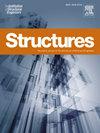多方向纤维铺设的多螺栓拉挤玄武岩玻璃钢接头的拉伸性能和载荷分布
IF 3.9
2区 工程技术
Q1 ENGINEERING, CIVIL
引用次数: 0
摘要
近几十年来,拉挤纤维增强聚合物(FRP)复合材料在桁架结构中大受欢迎。然而,拉挤玻璃钢板材固有的脆性特征导致螺栓间载荷分布不均,削弱了复合材料的强度优势。本研究侧重于拉挤纤维增强复合材料单柱多排螺栓连接的实验研究。目的是评估这些接头的拉伸性能,分析其载荷分布和失效特征。研究参数包括孔位置、排数、螺栓预紧力、板厚和螺栓尺寸。为了评估多螺栓复合接头中螺栓之间的不均匀载荷分布,引入了螺栓行载荷分布系数 (Ue) 的概念。研究结果表明,当端面直径比大于 3.5 和螺距直径比大于 4 时,失效模式从脆性剪切失效过渡到韧性销承失效。第一排的螺栓由于分担的载荷较大,最早出现失效。然而,增加中间排螺栓的预紧力或直径可有效缓解载荷分布不均的问题。此外,还介绍了确定多螺栓复合接头强度的计算方法。本文章由计算机程序翻译,如有差异,请以英文原文为准。
Tensile properties and load distribution of multi-bolted pultruded basalt FRP joints with multi-directional fiber lay-ups
Pultruded fiber-reinforced polymer (FRP) composites have gained significant popularity in truss structures in recent decades. However, the inherent brittle feature of pultruded FRP plates results in uneven load distribution among bolts, weakening the composite material's strength advantage. This study focuses on experimental investigations of single-column, multi-row bolted joints in pultruded fiber-reinforced composites. The aim is to assess the tensile properties of these joints and analyze their load distribution and failure characteristics. Studied parameters include hole location, row counts, bolt pre-tightening forces, plate thicknesses, and bolt sizes. To evaluate the uneven load distribution between bolts in multi-bolted composite joints, the concept of the bolt row load distribution factor () is introduced. The research findings highlight the transition in failure modes from brittle shear-out failure to ductile pin-bearing failure when the end-to-diameter ratio was more than 3.5 and pitch-to-diameter ratio was over four. The bolts in the first row experienced the earliest failure due to their higher load share. However, increasing the pre-tightening force or diameter of bolts in the middle row effectively mitigated load distribution unevenness. Moreover, a calculation method for determining the joint strength of multi-bolt composite joints is presented.
求助全文
通过发布文献求助,成功后即可免费获取论文全文。
去求助
来源期刊

Structures
Engineering-Architecture
CiteScore
5.70
自引率
17.10%
发文量
1187
期刊介绍:
Structures aims to publish internationally-leading research across the full breadth of structural engineering. Papers for Structures are particularly welcome in which high-quality research will benefit from wide readership of academics and practitioners such that not only high citation rates but also tangible industrial-related pathways to impact are achieved.
 求助内容:
求助内容: 应助结果提醒方式:
应助结果提醒方式:


